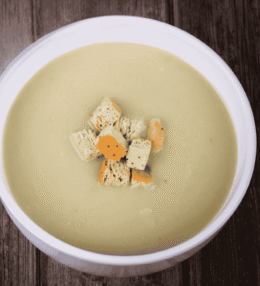
- View
Table of Contents
ToggleUdon, Japan’s thick wheat noodle, is more than just a dish, it’s a comfort food staple that has nourished generations.
Whether served in a delicate broth or stir-fried with savoury sauces, Udon’s chewy texture and ability to absorb flavours make it an essential part of Japanese cuisine. Known for its simplicity and versatility, Udon can be enjoyed in countless variations, making it a favourite in homes and restaurants alike.
Want to dive deeper into Japanese Cuisine? Don’t miss our post on 26 Traditional Japanese Foods to Try
What Is Udon?
Udon is a type of thick wheat noodle that holds a special place in Japanese cuisine. The noodles are traditionally handmade, with a firm, chewy texture that makes them perfect for both hot and cold dishes.
Udon is commonly served in a savoury broth made from dashi (a stock usually made from dried fish and seaweed), soy sauce, and mirin, with a variety of toppings like green onions, tempura, or a soft-boiled egg.
The simplicity of Udon allows the quality of the ingredients to shine, making it a deeply satisfying meal that can be enjoyed year round. What sets Udon apart is its versatility. In summer, it’s often served cold with a dipping sauce, while in winter, it becomes the star of hearty, warming soups.
From regional variations like Sanuki Udon from Kagawa, which is known for its firmness, to more elaborate dishes like Nabeyaki Udon (served in a hot pot), Udon’s adaptability makes it a beloved part of Japanese food culture.
Ingredients and Taste
The core ingredients of Udon are remarkably simple: wheat flour, water, and salt. These few ingredients are transformed through kneading and resting, producing the noodles’ signature chewy texture.
The real magic happens in how Udon is served. A classic bowl of Udon soup typically features a light but flavourful broth made from dashi, soy sauce, and mirin, giving the dish a delicate balance of umami and sweetness.
Toppings add depth and variety. Crisp tempura shrimp or vegetables can provide a contrasting crunch, while slices of kamaboko (fish cake) or a soft boiled egg introduce extra layers of texture and flavor.
Udon’s ability to absorb the rich flavours of its broth, while maintaining its firm bite, makes it a comforting yet versatile dish. The noodles themselves have a neutral taste, making them an excellent base for a wide range of flavours, whether they’re part of a hot, hearty soup or a chilled, refreshing dish.
A Taste of History
Udon’s origins in Japan date back over a thousand years, with some tracing its introduction to the Nara period (710–794 AD), possibly influenced by Chinese noodles brought to Japan by traveling monks.
Over the centuries, Udon has become deeply ingrained in Japanese food culture, with each region developing its own unique variations. In Kagawa Prefecture, Sanuki Udon is king, celebrated for its firm, al dente texture. In other parts of Japan, Udon is served in rich, comforting broths, often tailored to the local palate.
For example, in Kansai (Western Japan), the broth tends to be lighter, while in Kanto (Eastern Japan), the flavours are richer and more pronounced.

Japanese Udon (Thick Wheat Noodles)
Ingredients
- 400 g all-purpose flour
- 180 ml water room temperature
- 1 tsp salt
- Cornstarch or potato starch for dusting
Instructions
- In a large mixing bowl, dissolve 1 teaspoon of salt in the 180ml of water. Gradually add the salted water to 400g of flour. Begin mixing the dough with your hands or a wooden spoon, combining until it forms a rough dough.
- Once the dough starts to come together, transfer it to a clean surface and knead for about 10 minutes. The dough should become smooth, firm, and elastic. If the dough feels too sticky, sprinkle a bit more flour, but avoid over flouring to maintain the right texture.
- After kneading, shape the dough into a ball and wrap it tightly in plastic wrap. Let the dough rest for at least 30 minutes at room temperature. This resting time helps relax the gluten and makes it easier to roll out.
- Once rested, dust a clean surface with cornstarch or potato starch. Unwrap the dough and roll it out into a flat rectangle about 0.5 cm thick. Make sure to dust the dough and rolling pin lightly with starch to prevent sticking.
- To cut the udon noodles, fold the rolled dough into thirds (like folding a letter) and slice it into even strips about 0.5 cm wide. Carefully unfold the strips and dust them with starch to prevent sticking.
- Bring a large pot of water to a boil. Gently shake off excess starch from the noodles and add them to the boiling water. Cook for about 8-10 minutes or until the noodles are tender but still have a slight chew.
- Drain the noodles and rinse them under cold water to remove any excess starch and to stop the cooking process. Set the noodles aside while you prepare the broth or toppings.
- Serve the udon noodles in a hot dashi-based broth or with your choice of toppings like tempura, scallions, and a soft-boiled egg. You can also serve the noodles cold with dipping sauces. Garnish with finely sliced green onions or nori for added flavour.






